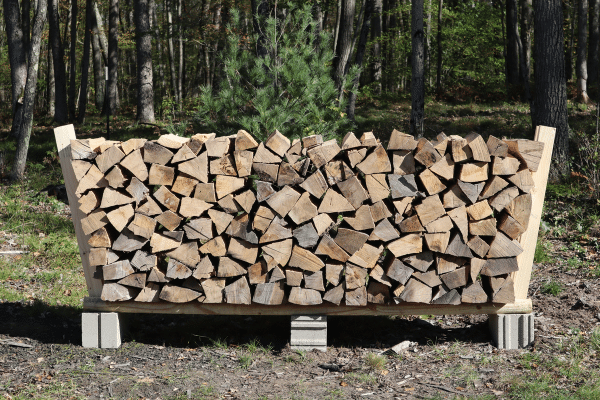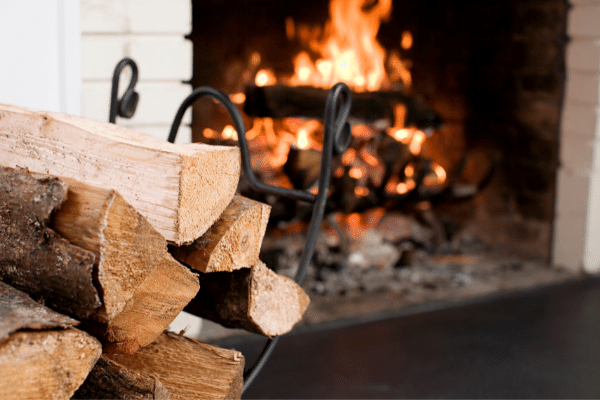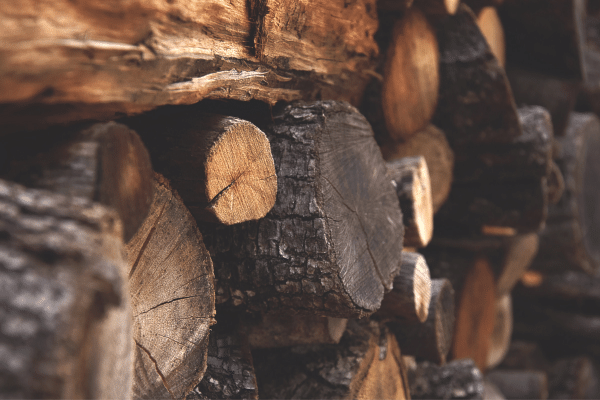- Home
- Best Firewood
- How to Store Firewood Outside
How To Store Firewood Outside
This post may contain affiliate links so I earn a commission.
Understanding how to store firewood outside will allow your wood to dry out as quickly as possible, while keeping it safe from mice, insects, mold and decay.
There's a lot more to burning firewood than just cutting up some wood, throwing it into a pile and expecting it to be ready to burn when you need it.
Plus, when you consider how much effort you've put into cutting up your wood, you don't want your hard work to go to waste.
The last thing you want to do is lose an entire weekend of work because you weren’t able to properly store your firewood outside.
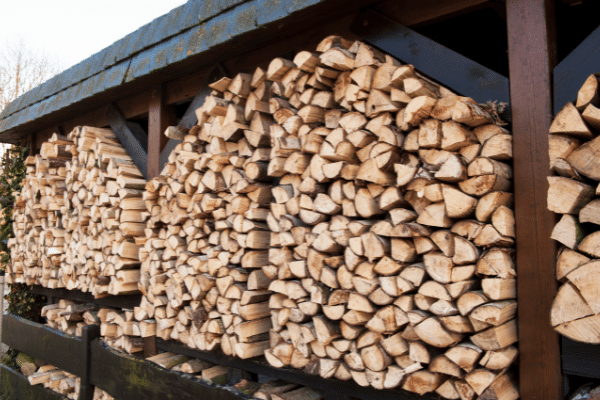
We all make mistakes, and those time consuming ones are the mistakes we learn from the most!
Be strategic with your outdoor storage methods, and you’ll have a healthy pile for months that will create a hot, clean burning fire everyone can enjoy.
How To Store Firewood Outside - Things To Consider
Understanding how to store firewood outside is a little more complicated than you think, but if you consider a few important steps it's a skill you can definitely master.
In order for a piece of wet firewood to dry out and become seasoned it needs sunlight, airflow, protection from the ground and protection above from the rain or snow.
Green firewood, or wood that has recently been cut, contains too much moisture inside the wood for it to effectively burn.
Seasoned firewood is wood that has been allowed to dry out for approximately 6-12 months, causing the moisture inside the wood to evaporate, leaving behind a nice, dry piece of wood that's ready to use.
Using Airflow To Dry Firewood
The summer sun and dry winds are perfect for seasoning firewood.
So in order to take advantage of this, choose a location that receives a lot of sunlight and not blocked from the breeze.
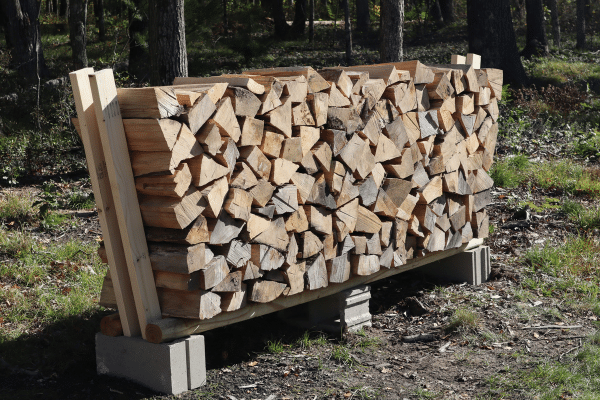
The drying process needs to happen from the top, bottom and the sides, but we will talk about more about that below in terms of elevating and covering the wood.
Also, if you're stacking multiple rows of firewood, don't forget to leave a 2-4 inch gap between each row of wood.
This allows the wind to flow between the stacks of wood, making sure the inner wood dries out as well.
Good air flow also reduces the possibly of mold growing on the wood which is important, especially if you plan on using your wood for a fire pit where inhaling mold spores is a possibility.
Don't Stack Firewood Against Your House
By stacking wood against your house, you’re limiting its shelf life.
Yes, it may slowly dry out, but it’s not going to get the full amount of airflow or sunlight it needs to stay healthy.
Stacking firewood against your home also significantly increases the odds of mice or carpenter ants entering your house.
Every year when I burn firewood that's stored in my firewood shed I find multiple mouse nests, spiders and other insects that have been living inside the firewood for months.
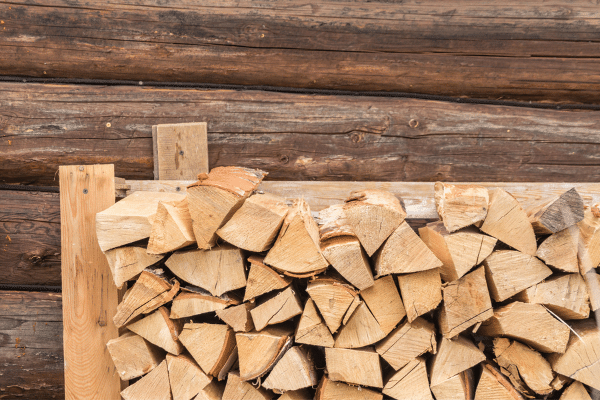
Since my wood is stored about 30 yards from my home or pole barn, I don't need to worry about a rodent or pest problem.
However, if the wood was stacked up against my home, I'd be pretty concerned.
Stacking wood against your house could cause damage to your siding too.
Having wood close to your home definitely makes it more convenient in the winter when you don't want to walk outside for an armload of firewood.
However, in the long run it's much better to store your firewood away from your house.
How To Store Firewood Outside And Keep It Dry
The final challenge of storing wood is keeping it dry.
There's a lot of different wood sheds you can build or buy that have slatted sides, designed to allow air into the wood.
However, since these can be a costly investment, you can keep it old school and just use a firewood rack or pallets if you would like.
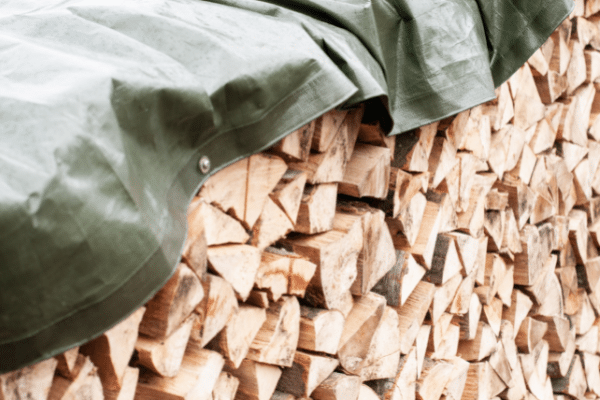
The most common method for keeping wood dry is by covering it with a tarp!
If you do cover it with a tarp, make sure only the top third is covered and you’re able to stake the tarp down.
Staking the tarp down will keep it wrapped tightly on top of the wood and allow for you to access it whenever you need while still protecting it from the rain and snow.
How To Store Firewood Outside - Your Options
When you’re making the decision on how to store firewood outside, you can be as fancy or basic as you would like.
In this day in age, you’ll be surprised at the amount of money you can invest in keeping your wood stored properly.
Keep Your Firewood Off The Ground
The first thing to know in storing your wood, is that it should be a couple inches off the ground.
Combining the wet ground with wood is a recipe for rotting and insect damage.
To elevate it off the ground you can use pallets, which you can normally find for free at a local business, 2x4 runners, or you can use a firewood rack.
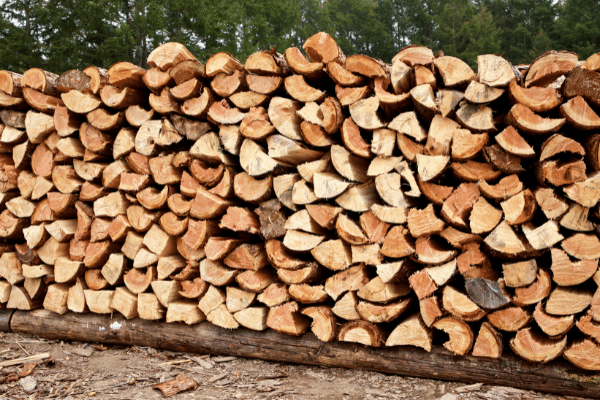
Pallets are one of the easiest ways to store your firewood because they're very stable and they last for years.
I like to pound a couple of T posts on the ends of the pallets for end supports allowing you to make your own pallet firewood rack in just a few minutes.
How To Store Firewood Outside Between Two Trees
A common option for many people is to store their wood between two trees.
Don’t shove the wood tightly between the trees because that can damage the tree itself.
Give yourself some room to spare on each side and under two pine trees can work great.
Cover it with a tarp and you’ll be good to go.
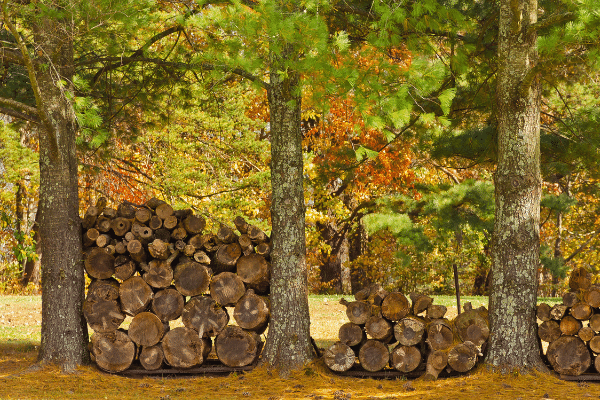
Just remember that wood stored between two trees for a long duration can cause damage to the support trees.
Also, as the support trees move and sway with the wind, a smaller tree may cause your firewood stack to fall over.
How To Store Firewood Outside In A Storage Shed
Yes, a storage shed can be a monetary and time investment, but if you’re one that needs firewood to heat your home, it’s worth the money.
You can build a shed if you would like.
These sheds look similar to animal pens, but they’re a bit more open to the elements.
Many people use slatted sides to keep the airflow strong through the wood.
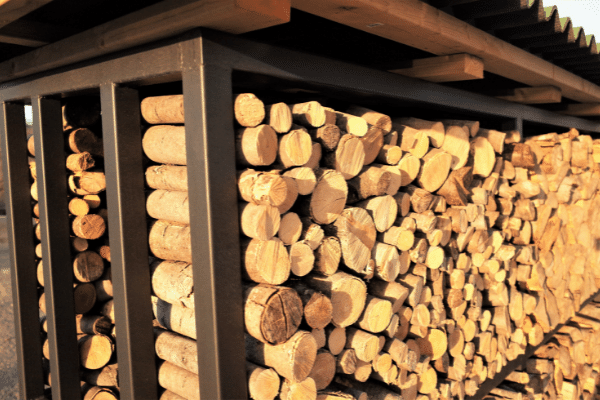
Also, a slatted bottom will allow air to cycle through as well.
Build the floor of the shed a couple inches off the ground so insects aren’t as tempted or able to get to the wood.
Again, pallets are one of the best floors for a firewood shed because they're simple to use and they work great.
Using A Firewood Storage Box
Now, be careful with a firewood storage box!
This shouldn’t be where you leave your wood to stay and a storage box should only be used to hold dry, seasoned firewood.
Consider this a halfway house for your wood.
If you go through wood regularly, keep the box full and make sure you’re going through that wood each week.
How To Store Firewood Outside - Overall
At the end of the day, it’s important to know that there’s not one exact way to store firewood.
Everyone has a different amount of space and effort they want to put into storing firewood outside.
As long as you remember that airflow and dryness are the two most important things for proper storage of firewood, you’re good to go.
We all know the frustration of working with wet wood when we’re desperately in need of a fire.
Put in the effort to properly store your firewood in the beginning and you'll have nice, dry firewood when you need it the most.
